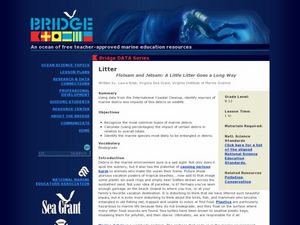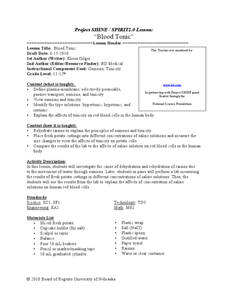K12 Reader
They See with Their Ears
Sometimes bats get a bad rap, even though they are fascinating creatures! Teach your class about echolocation with a reading passage. After reading, class members respond to five questions based on the text.
Curated OER
LitterFlotsam and Jetsam: A Little Litter Goes a Long Way
Students explore the concept of environmental stewardship. In this science lesson, students investigate data from the International Coastal Cleanup, identify sources of marine debris, and discover the impacts of this debris on wildlife.
Curated OER
Blood Tonic
Young scholars investigate the process of osmosis using fresh potato cuttings in saline solution. In this biology lesson, students explain the difference between hypertonic, hypotonic, and isotonic solutions. They collect data...
Curated OER
Geometry: Practical Applications of the Distance Formula
Students, working independently and in groups, apply the distance formula to practical situations. After solving various problems, students in pairs design coordinate planes from the school blue print to measure the distance from the...
Curated OER
Wacky Water Critters
Students visit a local creek or stream. They collect water samples from the creek and observe and sort the "water critters" they find in the sample, observing smaller organisms under a microscope if necessary. They identify each organism...
Curated OER
Solar S'Mores
Students see that solar energy is the energy given off by the sun. They explain that when light energy is absorbed by objects it is changed to heat energy and that dark-colored objects absorb more light and store more heat from sunlight.
Michigan State University
Interviewing
Do you have pests at your school? Find out through a series of interviews with school personnel. Scholars visit a variety of knowledgable individuals to ask them questions, record their answers, and present their findings to their...
Curated OER
Water Chestnut Graphing Activity
Students are taught how to format and enter data into an Excel spreadsheet. They make a graph and interpret graphed data. Students discuss possible impacts of water chestnut invasion. They graph data on water chestnut. Students report...
Curated OER
Snacks in a Bag
Students brainstorm a list of their favorite snacks. Using clues, they identify the type of snack being described. On a map, they identify and locate the origin of the ingredients used to make it. They write their own clues for...
Curated OER
Darwin's Principles
The author invested plenty of time in the presentation of this information; it is visually appealing, contains sound-effects, and displays creative animations and photos! Unfortunately, blank lines are included on most of the slides with...
Curated OER
Sounds Around
For this sounds worksheet, students choose one of five activities to do at home with parents. Students experiment with making sounds with natural objects, list "noisy" foods or count all the outdoor sounds that can be heard.
Curated OER
Sorting
Learners experience sorting. In this organization lesson, students play a computer sorting game called "Flood Game" on the "Between the Lions" website. Learners visit a library and observe and discuss book organization. Students work in...
Curated OER
Crops 2: What Plants Need to Grow
Learners explore agriculture by participating in a plant growth activity. In this botany lesson, students discuss what types of plants grow in their local environment and what the plants need to survive. Learners read assigned text about...
Curated OER
Make Sense of Nature
Students participate in this program that heightens their awareness and curiosity of nature as well as their sense of adventure and exploring new surroundings. They identify and choose an object from nature after exploring it with other...
Curated OER
"Chocolate" Reading Comprehension-- Informational Passages
In this reading for information worksheet, students read a one page text about the history and origins of chocolate. Students answer 5 comprehension and 5 vocabulary multiple choice questions.
Curated OER
Reuse, Reduce, Recycle Paper
Students experiment with recycling paper. In this paper recycling instructional activity, students conduct an experiment in which they dissolve newspaper in water and cornstarch to make new pieces of paper. They add color or flowers to...
Curated OER
The Present Simple-Daily Routines and Likes and Dislikes
In this daily routines worksheet, students read paragraphs telling about two peoples days, likes, and dislikes. They work in partners to ask and answer twenty-four comprehension questions about each section.
Curated OER
Crops 2: What Plants Need to Grow
Students explore the kinds of things that plants need to grow well.
Curated OER
Ready for Roots
Fourth graders sort seeds and predict what conditions are needed for them to germinate. They keep the seeds moist, observe and measure their growth and graph the results. As the seeds start to grow students compare and contrast the each...
Curated OER
Masai and I: A Cultural Comparison
Fourth graders orally share similarities and differences between their culture and the Masai culture based on their reading of Masai and I, by Virginia Kroll
Curated OER
Biology Trivia
In this biology trivia worksheet, students write short answers to 101 questions about animal classification, human anatomy, animal facts, and attributes of organisms.
Curated OER
Opera
For this history of opera worksheet, students explore and research what an opera is and then answer four questions regarding the history of opera in complete sentences.
Curated OER
What is Opera?
In this opera worksheet, 8th graders read about the history and evolution of opera as a type of theatre. They answer 4 questions based on the reading using complete sentences.
Curated OER
Archaeology: Quiz 57
In this archaeology worksheet, students answer multiple choice questions about kings, silk, and more. Students complete 4 questions total.

























